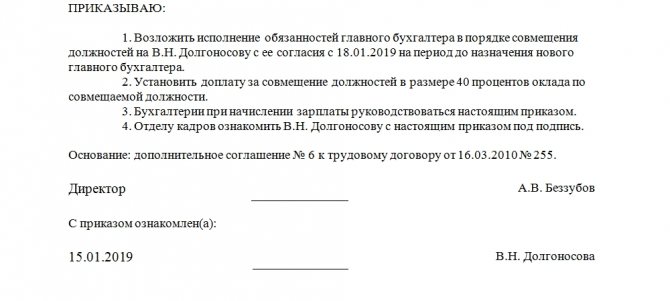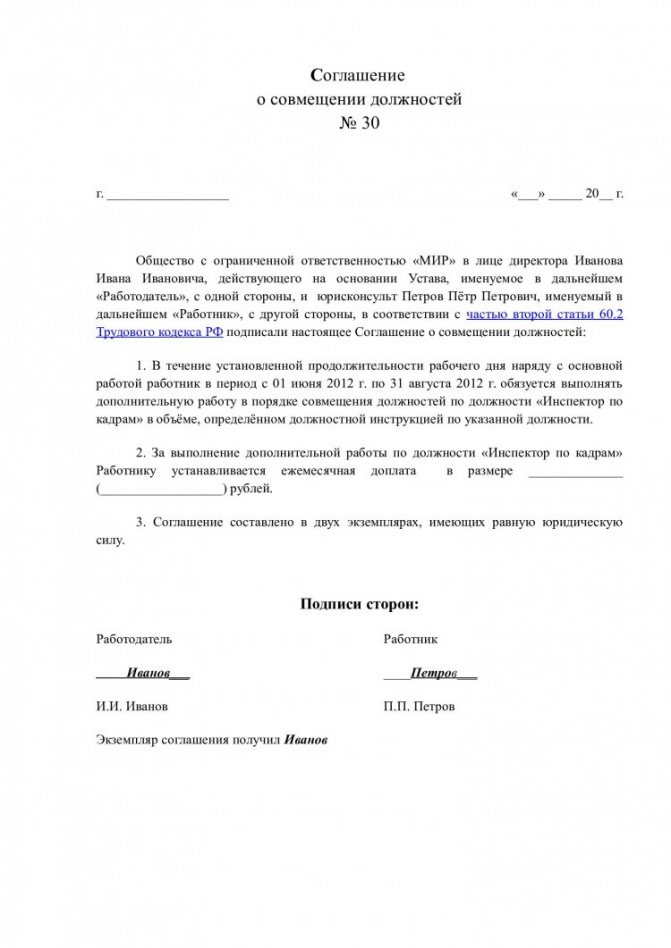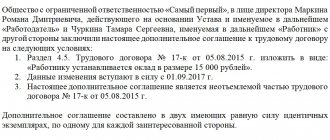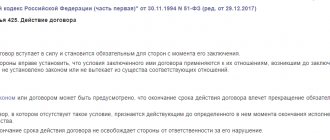Each employee working in the company is assigned a certain list of responsibilities corresponding to his specialization. But sometimes there is a need to increase the volume of work and expand its specificity. The procedure requires documentary support. In particular, it is necessary to draw up an additional agreement on the assignment of additional responsibilities.
- Form and sample
- Free download
- Online viewing
- Expert tested
FILES
Do not confuse combination and part-time
Part-time work is a broader concept. It involves performing different tasks at different times. That is, the responsible employee works at one of the places and performs only one set of tasks. And then, when working hours are over, he begins to perform the duties of the next position. Moreover, if you have a part-time job, you can work in different organizations.
Another thing is combining positions. Here the prerequisite is one leader and one organization. It is also possible to switch at the same time, if necessary, from the functions of one employee to the functions of another.
Judging from the employee’s point of view, combining positions is much more convenient than part-time work. Another difference: the first is defined in the second paragraph of Art. 62, and the second - in Art. from 282 to 288 of the Labor Code of the Russian Federation.
In short, when an order is issued to combine positions, in most cases there is no talk of a significant increase in time spent at the workplace. Rather, what is meant here is an increase in the area of responsibility of an individual employee. Of course, an increase in the volume of work should significantly affect the intensity of the employee’s duties.
Additional work: “combining professions” or “increasing the volume of work”?
If necessary, the company, with the consent of the employee, can entrust him with performing two jobs during a normal working day, that is, without going beyond the working hours.
This form of labor relations is called combination (Article 60.2 of the Labor Code of the Russian Federation). Combination of professions (positions) is the performance by an employee, along with his main work in the profession (position) determined by the employment contract, of additional work in another profession for the same employer during the duration of the working day (shift) established for him.
As a rule, the employee is entrusted with combining a vacant position or profession.
When expanding service areas or increasing the volume of work, the employee performs work in the same profession or position, which is stipulated by the employment contract, but to a greater extent compared to what he performed in accordance with the employment contract.
In what cases are positions combined?
Most often, the employer resorts to this measure temporarily. If, for example, he wants to “wait” for the main employee to return from vacation and therefore sees no point in hiring a new one. Or there is no suitable candidate on the labor market, and an already hired employee wants to try himself in a new position.
Attention! The combination conditions are different. The only thing you should make sure of before signing the order is that the decision made will not affect the overall efficiency of the company.
Who might be suitable for combination?
An ordinary case is the combination of positions within the same category. But it happens that an employee with the same job descriptions and tasks wants to perform diametrically opposed ones. The law does not prohibit such a combination. The main thing is that the candidate meets the necessary requirements, including qualifications, medical ones, and has the necessary knowledge and skills or shows potential for their development. Only extremely short-sighted managers agree to issue an order to combine positions for an unprepared employee.
Main components of an order
There is no special unified form for this kind of documents, since each organization has its own specifics. It must be taken into account in the content. However, there are data without mentioning which the order does not have proper legal force or can be challenged in court. These include:
- Full name of the organization. It should always be located at the top, in the middle of the sheet.
- Order number. It is then entered into the journal of orders on personnel matters.
- Date of acceptance (signing) of the document.
- The city in which the document is signed.
- Leader motivation. The formal style describes what prompted management to resort to combining several positions with one employee. It is advisable to draw up a separate order for each such person holding multiple positions.
- Link to Article 151 of the Labor Code. It talks about this right of the employer.
All this information relates to the basics, but is not directly related to what exactly is being accepted. The whole point is contained in several paragraphs of the order on combining positions. They must inform the reader about:
- Full name of the employee who assumes additional functions.
- The date the employee began combining positions.
- If available, end date. It may not be a date, but an event in connection with which such a combination is completed. For example, “until the appointment of a new secretary” or “until A.A. Ivanova returns from maternity leave.”
- Amount of additional payment for combination. Usually it is 40-50% of the salary.
- The one who is obliged to inform the employee that he combines someone else’s responsibilities.
As an additional link, information about the amendment to the employment contract can be located. Without such an addition, the employee cannot begin combining responsibilities.
At the very end of the order is the signature of the manager and the employee who accepts the fact of combining his position with someone else’s. Also, if there is a mention of the chief accountant, personnel officer or other specialists (if they are obliged to comply, take into account, inform, etc.), their signatures are also required.

Do I need to enter into a new TD?
Combining positions does not require the conclusion of a new contract. It provides that instead of drawing up a TD, an agreement of the parties is concluded here, which does not have independent legal force.
The existing contract is the main document, and the newly drawn up agreement acts as an annex to the main employment contract, which was previously drawn up by the parties.
How to draw up a part-time employment contract is written here.
Drawing up an additional agreement
The document begins with the name and details of the agreement to which it is attached. Must be indicated:
- date and place of imprisonment;
- parties to the agreement.
It is stated here that from a certain point the employee performs additional duties provided:
- with additional payment;
- without exceeding working time standards.
The document can use the wording: “expansion of the service area (sphere)” if the agreement provides for additional service of the number:
- company clients;
- patients in areas or wards;
- students or pupils;
- readers, passengers, buyers, etc.
The agreement can be concluded on a permanent or temporary basis, indicating the timing of the combination , if the part-time job appeared for a limited period, or indicating the reason for the combination, which will be the reason for the termination of the additional activity.
For example, if a colleague:
- went on maternity leave;
- went on a business trip or internship;
- issued sick leave for a long time, etc.
In this case, information about the timing will be expressed by the date of origin and termination of the employment relationship. Or an approximate wording: “during A.A. Ivanova’s maternity leave.”
If a permanent vacancy has become available for which a person is applying for a combination of positions, then the agreement is drawn up without specifying a deadline. In this case, it will be valid until the terms of the agreement are terminated bilaterally or unilaterally (what conditions should be contained in the employment contract is written here).
The validity period of the document or its indefinite (permanent) nature is indicated in the introductory part of the document . If this information is not included, then the agreement is legally binding:
- until the TD is terminated;
- before the main rate is reduced;
- until the part-time worker is dismissed from his main position.
The body of the document contains the following essential provisions in free form:
- list of functional responsibilities for an additional position;
- nature of work;
- amount of additional payment for combining positions.
The details and personal data of the parties must be entered:
- Company name.
- Type of ownership.
- Her details.
- Who does the company represent?
- Full name of the employee and employer.
- Positions of manager and employee.
- Division and position to be combined.
The wording of the main part may be something like this: “Submit to the senior cashier of the customer service department A.A. Vasiliev. combining the position of a sales consultant in the customer service department, with an additional payment to the basic salary of 30% of the base salary of a senior cashier, which is 8,965 (eight thousand nine hundred sixty-five) rubles.”
When drawing up an order, it is advisable to use similar wording.
Important! When combining positions, the employee must have the necessary competencies and, if necessary, the appropriate education.
Rights and responsibilities of an employee
The surcharge is calculated monthly and added to the basic salary , which is paid twice a month. It is calculated from the salary specified in the employment contract in a proportional percentage. Can be set at a fixed amount.
Labor leave is not provided. Vacation days are provided on the same basis as without combination, in an amount commensurate with the main position. However, an increase in monthly payments affects the amount of vacation benefits, which is calculated from average earnings.
The duration of working hours corresponds to the employment contract for the main position. However, the employer has the right to demand proper fulfillment of both basic and additional obligations, which allows for an increase in working hours.
Nuances
Completely new responsibilities of the employee are described in the addendum to the employment contract. But if the combined position has any financial responsibility, then the employee taking the combined position is required to sign an agreement on full financial responsibility. A link to it may also be present in the order.
By law, either party has the right to terminate the combination by notifying the other in writing at least three business days in advance.
If the order refers to a newly hired employee for two positions at once, then the link below should not be to the additional agreement to the employment contract, but to the employment contract itself.
One person can hold any number of positions. Each organization decides on the distribution of official responsibilities independently.
The employer is required to pay extra for the combination. An exceptional situation is when the job description clearly states that the employee’s duties include performing the duties of a colleague. The amount of the additional payment is specified separately in the order on combining positions, is taxed and depends on the amount of work performed, as well as on other factors taken into account by the employer.
How to conclude a hiring contract with an internal part-time worker? Sample additional document
In this section, you will learn about filling out an additional agreement to an employment contract on combination according to the sample.
Often, internal part-time work is dictated by the vacancy of a position during maternity leave or a long business trip, internship, etc.
At the request of the applicant, a replacement may be selected from among persons working for the same employer. In this case, the contract is of a fixed-term nature, limited to the period of absence of the main employee.
If a vacant position is open, at the request of the applicant, an employment contract for a period of one year can be drawn up, as well as permanent part-time work in the established amount, but not exceeding 0.5 of the rate.

It is preferably more convenient for an employer to draw up a fixed-term contract. But he can only rely on the officially stated request of the applicant.
Otherwise, arbitrary determination of the work period is unacceptable and is considered a violation of the applicant’s labor interests.
If, upon expiration of the contract, it is not officially terminated or extended for a commensurate period, its validity automatically becomes permanent (indefinite).
The essential provisions of the contract for taking office are:
- work time:
- vacations and days off;
- wage.
Working hours cannot exceed the established regulations - 4 hours a day. Accordingly, during a working week, a person can work no more than 20 hours.
Such standards correspond to half the rate, unless otherwise established by law (Article 284 of the Labor Code of the Russian Federation).
A separate clause specifies the frequency of performance of functional duties, which can vary as follows:

distributed evenly, 4 hours a day with a five-day week, with two days off.- Work only on weekends.
- The main operating mode is set on one or both weekends, with a commensurate reduction in load on weekdays.
Rest mode optional the contract is determined independently, regardless of the main employment contract. The days when the employee is released from part-time work are indicated here, providing for the rest required by sanitary standards of labor legislation.
Part-time workers are required to accrue vacation days. They are provided not as additional days, but as an additional payment to the vacation assigned for the main position.
The rest of the days not included in the vacation are not paid or provide for part-time work during the vacation in the main specialty.
Salaries are calculated in monthly installments and are issued on set days together with the basic salary. Its size is determined by calculating the amount of earnings from a fixed rate, or based on hourly wages.
If employees are provided with additional payment in the form of bonuses or thirteenth salary and other incentive payments, an internal part-time worker has the right to claim these payments.

The amount of wages and additional accruals for part-time work are indicated in the relevant provision of the contract in a separate paragraph, in numbers and in words.
The provisions established by the contract are subject to strict execution in order to avoid disputes. If changes are made to one or another essential provision, an addition to the main agreement is drawn up, indicating the changes being made.
A package of documentation when registering a part-time job may be attached to the application. Otherwise, the required photocopies of documents stored here in the HR department are used. Their list is regulated by the norms of Article 283 of the Labor Code of the Russian Federation.
If you need additional certificates for access to the workplace, a medical book required only for combination purposes, provide them at the request of the employer.
An entry in the work book about part-time work can be made only at the request of the employee, based on his submission of a written application addressed to the employer.
Sample additional agreement to an employment contract on combining positions.

Sample employment contract for internal part-time work.










